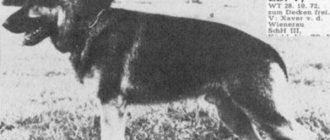The character of a dog depends on heredity and breed characteristics, but proper upbringing and training is also of no small importance. In this article we will tell you about the natural characteristics of the breed and how to properly start raising and training your pet.
The German Shepherd is one of the most popular dog breeds in the world. This is an intelligent and capable service dog. His dedication and courage are unmatched. He is amazingly versatile and trainable, one might even say universal. The German Shepherd is people-oriented, because of this, with proper upbringing and training, he is taken as a guide dog, as a rescue dog, for protecting territory or livestock, as a bodyguard, search and rescue, drug detection, and as a faithful companion and companion, he is irreplaceable.
- Country of origin : Germany
- Height at withers : male: 60-65 cm, female: from 55-60 cm
- Weight : male: 30-40 kg, female: 22-32 kg
- Lifespan : 9-13 years
- Usage : Service dog, watchdog, shepherd, companion dog
Who is the German Shepherd suitable for?
If you are planning to get your first dog, be smart and don't rely on its appearance or reviews from other owners. Each four-legged friend has a purpose and breed inclinations. German Shepherd - who is this breed suitable for?
Representatives of the breed are very active in childhood, adulthood and even old age. German Shepherds serve faithfully, even when they feel unwell or are depressed. When living in a house, the dog takes on the function of protecting the territory. She needs regular walks outside her apartment because she needs to interact with her family and get regular exercise.
If you live in an apartment, you need to anticipate all potential “inconveniences”. Until the age of 4 months, the puppy will need to be taken outside 5-6 times a day. Toilet training will continue for up to 8–10 months. In the first six months of life, the puppy should be actively walked and exercised, communicate with other dogs, and learn to make his own decisions.
An adult German Shepherd living in an apartment should be walked 2-3 times a day. One of the walks should last at least 40–60 minutes. A reduction in duration is allowed in extreme heat. During the hot season, it is advisable to move walks to early morning and late evening. Frost and snow should not be an obstacle to active walking.
A German Shepherd can lie quietly at the owner's feet in the evenings, but this breed is not suitable for people leading a sedentary lifestyle. Until approximately one year of age, the owner needs to invest every effort in raising and socializing the puppy. When the dog turns 1 year old, the intensity of training decreases, but it should not stop.
Note! If your German Shepherd doesn't get enough exercise, its behavior may become unacceptable.
He or she?
Think about what gender your puppy prefers. You need to choose carefully.
Each gender has its own advantages and disadvantages, this affects the character and some reactions.
| Criterion | Advantages and disadvantages of Male | Advantages and disadvantages of Bitch |
| Character | Tendency to display leadership qualities, which leads to stubbornness and requires greater persistence in training. The habit of “marking” territory. | They are more trainable, flexible, more attached to their owner, and more loyal. An excellent option for a beginner. |
| Service Application | All year round | Twice a year (during the period of heat) the dog becomes disobedient, tries to run away, and this lasts up to 21 days. |
| Benefits from breeding | Receiving payment for mating only if it has great value as a producer. | Puppies are usually sold once a year, and there are up to 10 of them, which brings a good income to the owner. |
| Sexual hunting | Always | 2 times per year |
| Physical qualities | Stronger, tougher, bigger | Less strong and smaller in size |
| Preferred Application | Security, sports, escort | Companion for children, guide |
Girl or boy - the important question has been resolved. The breeder has been selected. That happy day comes when a theoretically savvy future dog breeder sets out to get his own German Shepherd. Rest assured, this day will be remembered for a lifetime! Be prepared that you will like all the puppies that are shown to you, but don’t give in to emotions, you will still have to choose one.
We choose based on two criteria – behavior and appearance. Remember for what purpose you need a shepherd dog; if working qualities are a priority, then character is more important; if you want a star of exhibitions, then pay attention to appearance when choosing.
Types of German Shepherds
Remember, the German Shepherd species is a myth! There is only one breed standard, but there are several breeds similar to the German Shepherd.
The German Shepherd is a versatile herding and working dog. Unfortunately, during the selection process, the breed has changed a lot and not for the better. Today's breeders and buyers value appearance over health. Your task is to find breeders whose priorities are set differently.
The German Shepherd is a medium-sized dog with a lean and muscular build. Representatives of the breed have a strong, harmoniously built bone structure, which is also a “weak” point.
In adulthood, the height of dogs is:
- Males: height 60–65 cm; weight 30–40 kg.
- Females: height 55–60 cm; weight 22–32 kg.
Note! In a mature dog, body length is 10–17% greater than height. Bitches have a longer physique than males.
Key points of the breed standard:
- The head is wedge-shaped, proportional, dry, moderately wide. The length of the head is approximately 40% of the height at the withers. The ratio of the length of the skull to the length of the facial part is 1:1. When viewed from the front and side, the forehead is slightly rounded, without a furrow or with an insignificant furrow.
- The teeth are white, strong, in full set and in the correct bite. The incisors are strictly parallel.
- Jaws – strongly developed, proportional.
- Lips are dry, black, fit tightly, completely hiding the teeth.
- The nose is only black.
- The eyes are expressive, almond-shaped. The cut is a little slanted. The look is calm, attentive. The color of the iris is brown, as dark as possible.
- The ears are only erect, strictly parallel and vertical, medium, triangular with sharp tips.
- The neck is strong, muscular, without excess skin, set at an angle of 45%.
- The neck should be strong, well muscled and free of throat dewlap. The angle relative to the body (horizontal line) is approximately 45 degrees.
- The body is strong, proportional, the back is straight and sloping. The loin is wide, the croup is long. The chest is proportionally wide and long, oval. The height of the sternum is 45–48% of the height at the withers.
- The tail is arched, reaching to the hock joints. The tail should not rise above the spine, even when the dog is excited.
- Limbs – powerful, strictly parallel, flexible. The hind legs are slightly lowered and pulled back. Elbows and knees are directed strictly back, not tucked in.
- The paws are rounded, gathered into a ball, the claws are as dark as possible.
- The skin is dense, elastic, without folds.
- The coat is semi-long with undercoat or long with undercoat.
- Colors: black and yellow, black and gray, black and red. The back and muzzle mask are as dark as possible. The undercoat is light gray.
German Shepherds move at a trot or a confident walk, but smoothly. When moving, the dog's back should not arch or hunch. When running, the dog is almost flying, the tail is tense, the ears are flattened. The line from the nose to the tip of the tail is smooth.
The German Shepherd should be balanced, patient, confident, calm, friendly, attentive, easy to train and teach.
Representatives of the breed have a pronounced fighting (service) instinct and endurance. German Shepherds are courageous and excellent at their jobs.
Weight by month
Newborn German Shepherd puppies weigh from 450 to 600 g. Receiving all the nutrients the body needs from their mother’s milk, they grow quickly, gaining weight from 50 to 100 g per day. At 1 month, a healthy baby should weigh from 2.5 to 4 kg, the height at the withers ranges from 19 to 23 cm. The wide range in weight is due to several factors:
- gender of the puppy (smaller females);
- number of heads in the litter;
- First-born bitches tend to have smaller puppies.
The one month old puppies are already walking well. Their eyes are open, their color may be bluish, but soon the color of the iris will change to brown. The eye shape is almond-shaped.
At 2 months, puppies weigh 7-9 kg. The babies are already confidently eating food, sucking less and less from their mother. This is the optimal age for weaning a puppy from a bitch and handing it over to new owners. At this age, the first vaccinations are given. At 3 months, the shepherd’s height reaches 40-44 cm and weight 14-17 kg. The puppy's owner unobtrusively begins raising the baby. By 4 months, the puppy should weigh 16-20 kg. The baby is active, runs and plays a lot. From this age you can start training your puppy.
How to choose a healthy puppy
The answer to the question of how to choose a healthy puppy consists of two parts.
First of all, you must make sure that the puppy does not have any shortcomings or defects of the standard:
- In a male dog, the testes should be lowered into the scrotum. Cryptorchidism is a disqualifying defect, even if corrected surgically. Insufficiently developed testes are also a defect. If in doubt, your puppy should have an ultrasound.
- Barrel or flat chest. In puppies this defect is clearly visible.
- Low set, hung to the sides, drooping, tucked inwards, not strong ears. Puppies begin to develop ears at 2-3 months of age, but they may fall off during the period of teeth change.
- Significant lack of pigment: albinos, lack of a mask, light iris, piercing or expressionless gaze, light claws, red tip of the tail, brown nose. Light markings on the chest and legs are highly undesirable but acceptable. In the previous breed standard, white markings were considered a fault. After molting, puppies may change color, length and structure of fur, so you need to focus on the parents. White undercoat color is unacceptable.
- Disadvantages of the dental system: any bite except scissors. Any deviations from the dental formula. In puppies, defects in the dental system are detected only by x-ray examination! There are no other methods; parental data does not guarantee correct bite in puppies. Any defects in baby teeth are a guarantee of problems with bite and dental formula.
- The tail is a ring, creases and a helical structure of the tail. Corrective tail surgery is not permitted.
- Incorrect bone structure, hip dysplasia - a dog’s health can only be confirmed by a veterinary examination! Collapsed or twisted knees/elbows - this disadvantage only gets worse with return.
- Long coat without undercoat, curly guard hair, parted on the back.
A weak psyche (attempts to bite a person, timidity) is considered a vice. Even at the age of 1–2 months, puppies show determination, endurance and sociability. Congenital mental defects cannot be corrected through education.
Male: character
Advantages:
- High performance, very durable
- Solid appearance, a big plus for exhibitions
- Persistence in achieving results in the learning process
Flaws:
- Independent and more stubborn than a girl. Requires more strict training than a girl.
- To fulfill your physical and natural needs, you need a longer time for walks. According to physiology, he is not capable of quickly emptying the bladder.
- Can run away from its owner if it smells a female in heat.
- During the period of estrus in females, fights with other males are possible.
Age features of choice
The age characteristics of the choice serve as guidelines at the time you choose a nursery or breeder. Before buying a puppy, be sure to make sure that it is examined at a veterinary clinic, and if the breeder has not done this, you should insist. If the breeder claims that the puppy is healthy, but does not provide documentary evidence, you are better off going to another nursery.
1 month
Professional, conscientious breeders do not sell puppies under 1 month of age under any circumstances. Month-old German Shepherd puppies do not have distinct breed traits. In addition, if you do not have experience, they may literally hand you a mongrel dog.
2 months
At 2 months, German Shepherd puppies confidently consume supplementary food, receive their first worm prevention and vaccination. Usually, from the age of two months, puppies are put up for sale “for reservation”. At this point, a veterinarian who monitors the progress of the litter may be able to identify puppies with defects.
Important! Minor defects in the breed make breeding impossible, but they do not make the dog worse.
If you do not plan to show your pet at shows or breed puppies, purchasing a baby with color defects or incorrect ear placement is an excellent opportunity to purchase a service dog at a reasonable price.
3 months
At 3 months old, German Shepherd puppies are ready to go to a new home and are vaccinated. Typically, from the age of three months, breeders allow puppies to be viewed in person. When choosing a puppy, pay attention to the behavior of the entire litter. Already at this age, if you observe carefully, you will notice differences in the dogs' temperament.
Be sure to pay attention to the mother, she should be worried, look tense, but should not show aggression. It is extremely important that the dog owner stays with you at all times. Watch the behavior of the breeder; if he treats the puppies roughly, you can draw conclusions about his attitude towards the dogs and the breed as a whole.
Note! When choosing a puppy, you should look at the entire litter. Even if some of the puppies are sold, ask to see photos of them. Intentional concealment of part of the litter, most often, indicates a breed defect, which was identified during the initial breeding inspection.
4 months
Selling German Shepherds at the age of 4 months should not make you suspicious. Considering that responsible breeders offer puppies for sale at three months, the absence of purchase offers within a month is quite normal.
Moreover, at 4 months of age, a German Shepherd puppy has more noticeable defects and temperamental characteristics. At this age, you can evaluate how confidently the puppy's ears stand up. The lack of documents about a veterinary examination when the puppies are 4 months old should alert you.
5 months
Typically, puppies are kept by breeders for up to 5 months if they are sold under mandatory castration conditions. This is possible if the puppy has a breed defect that does not affect health and temperament. For a buyer who does not want to build a dog's career, buying a five-month-old puppy does not pose any threat.
Testing for the puppy and its future owner
To find out which puppy is mentally healthy and whether the dog’s character matches the breed characteristics, conduct testing.
Dog character and reactions:
- Active, keenly interested in who came to us? Runs towards you, curious.
- Playful and cheerful - wags its tail.
- Active defensive position. Clap your hands and observe the reaction, if he is alert or even yelped - well done! He squealed and tucked his tail - he was a coward.
- Babies may try to growl and bite you - this is not a good sign; their psyche is unstable.
- He explores a new subject, actively contacts it - a serious guy, he will grow up assertive and militant.
The following signs will help you choose a healthy puppy:
- The eyes are clean, without traces of streaks.
- You need to pay attention that there is clean hair under the tail - a sign of healthy digestion.
- Wet nose.
- Legs are smooth, straight, without signs of rickets.
- Those who have a body that feels dense, elastic, and well-fed have good health.
- There is no pronounced “dog” smell.
- The abdomen is not swollen (a sign of worms) and is of normal size.
- There are no bald spots on the skin, the stomach is clean - without rashes and acne.
What will the dog be needed for?
It is important to answer the question, what will the dog be needed for? If you consider a German Shepherd as a friend, family member and companion, whether he has documents or the breed as a whole does not matter at all. Respectable breeders make sure that puppies that are sold “for the pillow” are neutered according to age and are not used for chaotic breeding.
If you plan to show your dog at exhibitions or engage in breeding activities, choosing puppies that will become future producers is the last stage. First of all, you need to study a lot of theoretical material about the history and characteristics of the breed, become a member of the breed club, meet experienced colleagues and establish contact with them.
Dogs that are initially purchased for puppy production must be selected using stricter criteria. It is important to understand that any genetic defect can manifest itself before the age of 1–3 years, in which case the dog and all puppies obtained from it are discarded from breeding.
Description of the breed
German Shepherds are medium-sized dogs with strong bones and well-developed muscles. They have a long wedge-shaped head with a slightly convex forehead, powerful jaws and dark almond-shaped eyes.
The paws of representatives of this breed are straight, set parallel to each other, the ears are triangular in shape, erect.
The height at the withers for males is 60-65 cm, they weigh 30-40 kg, females grow to 55-60 cm with a weight of 22-32 kg.
The coat is dense and hard, short on the head and front of the paws and slightly longer on the neck, with undercoat.
- solid black;
- black-backed - black with markings of yellow, red-brown, brown or light gray;
- zonal;
- black and tan.
It is acceptable, but not desirable, to have small white spots on the chest and light colored fur on the inner surface of the body..
The agony of choice - boy or girl
Almost all potential dog owners experience the agony of choosing between a boy or a girl.
- If you are not adopting a dog for breeding, it is better to have it neutered at a young age. Neutered males and females behave approximately the same.
- If you choose a puppy for breeding, it all depends on the seriousness of your intentions. If you are ready to raise puppies, monitor their fate, and face difficulties associated with genetic abnormalities, buy a girl.
- You like the prospects of showing your dog at exhibitions, participating in the development of the breed, but you are not ready to turn your home into a kindergarten - then it makes more sense to buy a male dog.
Advantages and disadvantages
German Shepherds have outstanding service qualities, which are inherent in them at the genetic level and allow representatives of this breed to be used in completely different areas: from protecting the territory to detaining criminals and searching for various dangerous objects.
But this is far from the only advantage of German shepherds.
Positive qualities also include:
- intelligence and learning ability;
- devotion;
- unpretentiousness in maintenance and feeding;
- lack of inclination to conflicts and aggression for no apparent reason;
- energy, endurance;
- the ability to establish good relationships with all household members, including small children;
- lively character and stable psyche;
- affordable price.
In addition, these dogs can be kept not only in an outdoor enclosure, but also in private houses and apartments, subject to daily long and active walks.
Along with their advantages, German Shepherds also have a number of disadvantages.:
- the need for professional training;
- the need for daily communication with a person, active games, activities and walks;
- the possibility of aggression in the absence of proper education and socialization;
- specific smell and presence of fur in the room, especially during molting;
- problems with digestion and the musculoskeletal system.
Dogs of this breed require a special approach to education and training, therefore they are not suitable for inexperienced breeders.
Pedigree of the puppy: with documents or cheaper
Pedigree of the puppy: with documents or cheaper? If you have chosen a German Shepherd based on breed characteristics, buying a puppy without documents is an extremely unwise choice. The absence of documents indicates that the dog is not purebred. You can adopt such a dog for free, from a shelter or from volunteers.
This is interesting! Statistically, the majority of mixed breeds throughout the world have German Shepherd heritage.
Many people believe that puppies with documents are much more expensive. In fact, the price increases slightly, especially if you buy a non-show class puppy; such animals are sold much cheaper.
Where is the best place to choose and buy a pet?
The choice of where to purchase a puppy depends on the purpose. If the animal is planned to be exhibited at various competitions and a pedigree with a full package of documents is required, then it is best to buy a dog in a kennel or from a trusted breeder, who can be found through reviews or in official sources.
If you need a shepherd for breeding, then it is also recommended to purchase your pet in places that do not raise doubts. It is better to purchase from a breeder who will provide all the necessary documents. You should not purchase a puppy from dubious organizations; there is a high risk that the dog is a crossbreed or a defective breed.
It is better to buy German Shepherds from kennels
If you need a pet to protect your home or for “friendship,” then you can buy the animal from a private owner. However, before doing this, it is advisable to familiarize yourself with the breed standard, so that instead of a German shepherd you do not end up with just a dog that looks similar in appearance.
The highest price for dogs of this breed is in kennels. However, only trusted breeders can guarantee the availability of an animal that meets all standards.
Choosing a puppy based on character and intelligence
Many potential owners prefer to choose a puppy based on its character and intelligence. It is important to understand that a dog’s temperament is distinguishable even in childhood, but mental abilities are an individual indicator.
Important! There are no stupid dogs; their development and skills depend only on the owner.
German Shepherds are working and trail dogs. They need a reliable and balanced leader, only in this case they will be happy. If you expect a dog to have the ability and inclination to make absolutely independent decisions, a German Shepherd is not the best choice.
Bitch: character
There is an opinion that German Shepherd females have a more submissive and gentle character. But experts believe that character largely depends on heredity and individual characteristics. There are always exceptions, bitches with a very difficult character, and there are males with an easy-going and submissive character. But still, there is a difference in the behavior of the sexes. There are advantages and disadvantages for female and male genders.
Advantages:
- Strong relationship with owner and home
- Emotionally sensitive perception
- Girls are smarter and smarter than boys
- Accepts training tasks well
- During walks, he runs less in the bushes
- Doesn't rush at strangers
- The breed is ideal for breeding, just one assessment from the exhibition is enough
Flaws:
- Sly
- Periodic menstruation
What you need to prepare at home
Before purchasing a dog, be sure to consult the breeder about what you will need to prepare at home.
The standard set is as follows:
- Several sets of toys.
- Resting-place.
- Bowls and equipped area for eating.
- Permitted place for relieving yourself.
- Regular food for 7–14 days.
Depending on the dog’s temperament, you need to arrange the resting place as successfully as possible - closer or further from your room. It is advisable to walk around the area near your house and choose an area for your first walks.
At what age is it recommended to buy a puppy?
Experienced breeders recommend buying a puppy at the age of 3-4 months. It is during this period that the animal can already be trained, weaned from breastfeeding and branded. Some breeders also purchase older dogs, but it is important to understand that the earlier the pet’s training begins, the better.
It is best to purchase a German Shepherd puppy at the age of 3–4 months.
When buying a puppy, you should ask the breeder about how to properly feed and raise the baby. The first months of life in a new home are considered crucial for a dog. It is important that the adaptation period is as favorable as possible.
Nutrition
When feeding, you need to follow a number of rules:
- should always cool and fresh water ;
- eating at a certain time;
- any vegetables without exception;
- bone without meat, once a week;
- fresh products;
- when using dry food, consider the age and physiology of your pet;
IMPORTANT! Do not feed from the table!
A dog can eat any type of meat (except fatty pork), cut into small pieces. It makes up a third of the daily diet.
When feeding saltwater fish, remove all bones . Once a week - raw egg yolk.
All non-crushed cereals, especially buckwheat and rice. The cereal needs to be soaked overnight, then cooked for 10 minutes. Vegetables are added to food raw, finely chopped.
Just like any other breed of dog, a German dog can be fed dry food.
Prohibited Products
- beans;
- pasta;
- sugar;
- sausage;
- canned food;
- potato;
- wheat bread;
- semolina.
ATTENTION! Feed your shepherd 15-20 minutes after walking.
Is it possible to keep it in an apartment?
It is possible to keep a German Shepherd in an apartment and it will not cause any difficulties, but only if several conditions are met.:
- when choosing a place, it is necessary to take into account the size of an adult pet - the dog should be comfortable, it should be able to stretch out to its full height during sleep and rest;
- a bed, mattress or bedding should also be selected in accordance with the size of the animal;
- The place should be chosen so that the pet can see the entire room and doors from it - this need is due to the watchdog instincts of the German Shepherd.
What to look for when purchasing
What is important to do before buying a dog:
- check documents;
- examine the puppy;
- evaluate the animal using the Campbell test;
- pass the compatibility test.
Before purchasing German Shepherd puppies, you need to carefully inspect them.
Attention! Before purchasing an animal, it is recommended to find out how many puppies were in the litter. If more than 10, then you should not purchase such a pet. In large litters, puppies often lack nutrients.
Required documents
What documents must a breeder provide when selling a puppy:
- metric or certificate;
- pedigree compiled in accordance with all the rules of the International Canine Federation;
- puppy inspection report.
What must be indicated in the certificate:
- parents' nicknames;
- suit;
- date of birth;
- registration number;
- nickname;
- Full name of the buyer;
- breeder's address;
- club details.
Bitches are more expensive than males, as they are used for breeding. On average, a dog with documents can be purchased for $1,000. This is the minimum price. Without documents, but with a pedigree, a pet will cost $600.
Attention! You can buy a second-hand puppy for $100–200. However, before this, the animal should be carefully checked to ensure compliance with the breed standard.
Meeting the Standard and Defining Character
What a healthy pet should look like:
- there must be a mark on the thigh that matches the data in the metric;
- almond-shaped eyes are brown with dark or yellowish irises;
- regular scissor bite, 28 teeth;
- the head is proportional to the body;
- clean mucous membranes;
- black nose without additional inclusions;
- long and straight tail;
- short and straight back;
- large paws;
- color - black, black-brown, yellowish, gray;
- The ears are large and slightly raised.
Puppies must meet the breed standard, just like their parents
Signs that indicate a mongrel or mestizo:
- fear at the sight of a person;
- nose is brown or yellowish;
- drooping forehead;
- hairs between eyebrows;
- tail twisted into a ring;
- short legs;
- long back, there may be deflections;
- pointed muzzle;
- malocclusion;
- too large or, conversely, small head.
To determine a puppy's abilities, you need to watch him run. A purebred dog is always coordinated and does not fall to one side, which is more often characteristic of mixed breeds.
The Campbell test is also used to assess character and abilities, which includes:
- assessment of the parents - if dogs are aggressive, fearful or unsocialized, then this can be passed on to the puppy;
- assessment of the pet’s behavior - the puppy must make contact, not be afraid of noise and people, follow simple commands, and also strive for dominance. At the same time, the animal must get along with its parents, not fight or bite with them.











